Foreword
I appreciate the opportunity of writing a foreword to this interesting book.
I can recall the early pioneers of Methodism in Yelden and was with feelings of pride on the part of these pioneers to show me on one occasion the Documents and other relative matter pertaining to the building of the Church.
Since that day the work has continued, many have passed on to their reward. Although a village of less than 100 total population, the Methodist cause flourishes and the Sunday School though naturally small in numbers is the life of the village.
Admiration is evoked at the dogged but loving perseverance of those at present “holding the fort”.
Many young men have passed through the school and can vouch for its influence and help.
May the work continue to prosper and really “grow”.
W E Capon
Rushden July 1940
|
Yelden is a parish in the county of Bedfordshire situated in the heart of England about sixty miles from London. The land area of the parish itself is 1950 acres.
The village is scattered; the houses being principally built around the three main roads. The houses themselves are constructed for the most part of mud-plaster on a wooden skeleton, with thatched roofs, only a few being of red brick structure.
The village parish Church, well placed on high ground, is a 13th century building which was re-modelled in the year 1340 with the West Tower 14th century, and the South Porch 15th century additions; the windows are of 14th century design, and the Church is dedicated to St. Mary the Virgin.
The Methodist Chapel in the village was built in the year 1884 on the site of a former Chapel.
The present Sunday School in connection with this Methodist Chapel was inaugurated in 1924, and it is from this Sunday School that the idea of compiling this book was conceived.
|
Approaching Yelden from the neighbouring village of Chelveston through the ‘open fields’ large areas of cultivated land undivided by hedges, and drained by large dykes a veiw of which can be seen in our first picture.
|
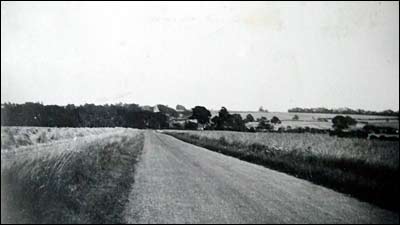 |
Our second veiw is a winter scene of an approach to the same ‘open fields’ from the village of Newton Bromswold; snow can be seen on the trees in the foreground.
|
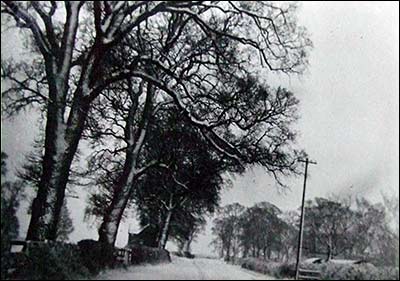 |
Here we have a snapshot of the village Church, taken at the entrance-gate of the Churchyard. The tree by the side of the path is a yew tree, and is to be found in most Church surroundings.
|
|
The first two photographs on this page are taken from the Castle Hill – mention of which will be made later – looking North-west.
In the first photograph the church can be plainly seen surrounded by some houses and a small farmstead.
|
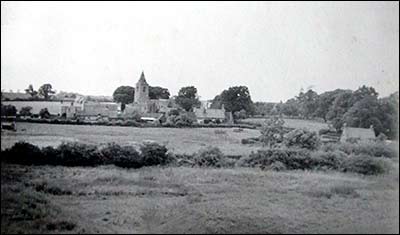 |
| The second photograph is taken from the same site looking South-west. In the foreground can be seen the village pond, beyond which can be seen the main section of the village including the village inn. To the right of the pond one can see the village Institute. |
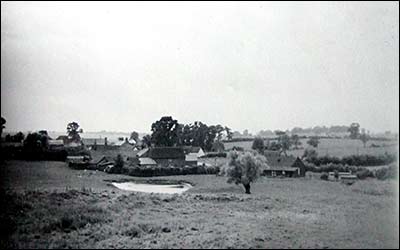 |
Our third view is taken looking on the village from the North-east and one gets a picture of English rural beauty.
|
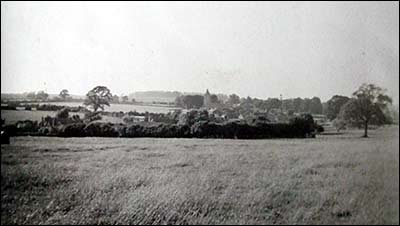 |
Here we see boys and girls boarding the school bus, which takes them to the neighbouring village of Riseley. Children of the age of 5 to 14 years depart in the morning at 8-30 and return home again at 4-30. About 20 scholars from Yelden make this journey daily, five times a week.
A charge of one shilling per head is made, which provides for a mid-day meal which is cooked with the help of the senior girls; the boys providing vegetables from the school allotments.
|
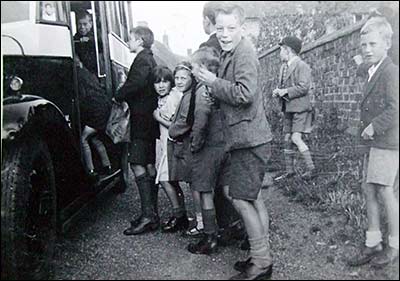 |
| This photograph shows a view of the disused village school. |
|
The next view is one of the main street and the village store and post office. Farther along this street on the right, opposite the thatched cottages, is situated the Methodist Chapel, which, owing to the curve of the road, cannot be seen.
|
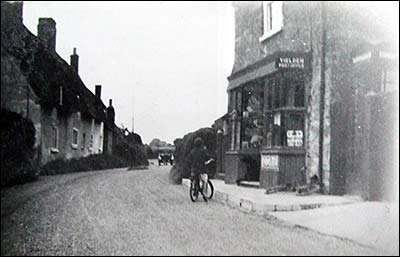 |
We find portrayed on this and the following page, birds and animals that are found in fields and on the farms.
Here we see a group of Aylesbury ducks cleaning their plumage in the morning sun, a common site on the farm.
Poultry are kept the villagers, the eggs being sent to the egg-market held in Bedford, thirteen miles distant, each Saturday.
|
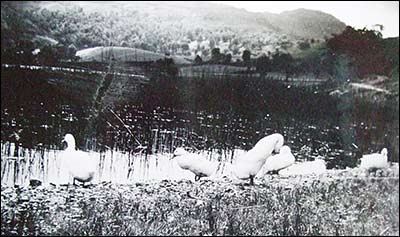 |
In our next picture, is seen a mother-hen excercising her chicks among the grass of a local field.
The turkey is a difficult bird to rear, due to the dampness of the clay soil; but here we see a fine specimen of an English turkey. The farmer’s wife or daughter usually feeds and takes care of these birds, which are in demand for Christmas fare.
|
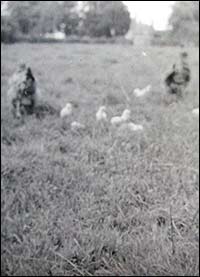 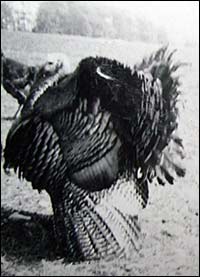 |
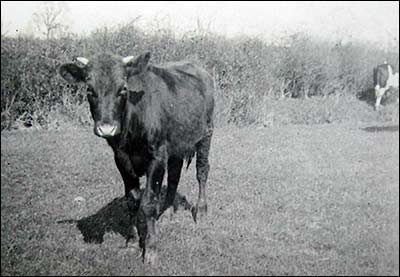 |
On this page are seen animals customary on every form. Owing to the increasing consumption of milk in the day-schools of England, the cow has grown in increasing importance.
Children can obtain daily from their teacher an allowance of this body-building beverage. In most towns the milk-bar has grown in great popularity.
During the summertime the cows are seen grazing in the open field, but in the wintertime, are cared for in specially built sheds.
|
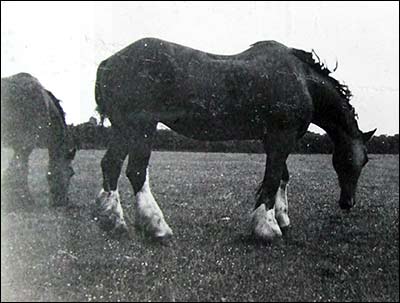 |
The horse is still an important and invaluable animal, although on many large farms it has been displaced by the motor tractor.
In this picture is seen an English Shire horse at leisure in a field, after his day's work is ended.
|
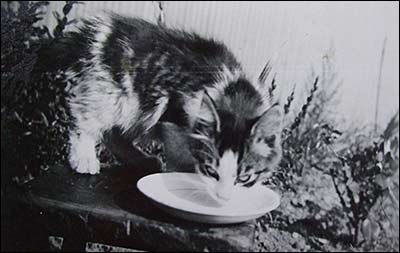 |
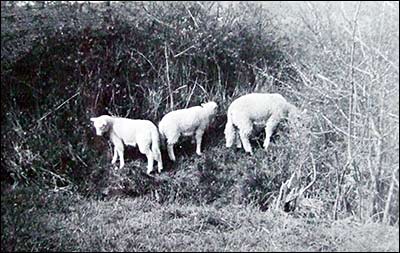 |
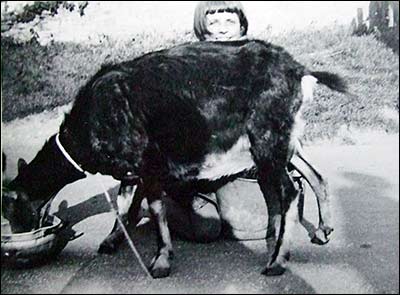 |
The cat is a member of most farm households, for it rids the house and barns of rats and mice: pussy here is seen taking its morning milk from a saucer on a stool.
Goats are kept on some farms as pets, their milk being much richer than that of the cow. Our picture shows a farmer’s daughter enjoying the task of milking the goat, while 'nanny' patiently eats from the bowl.
In the spring, one of the most beautiful sights on the farm, are the fleecy white lambs, here we see a close view of one of these playful creatures, and above, three lambs are seen searching for tasty green shoots.
|
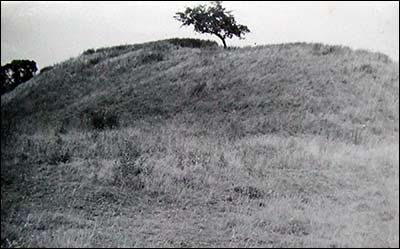 |
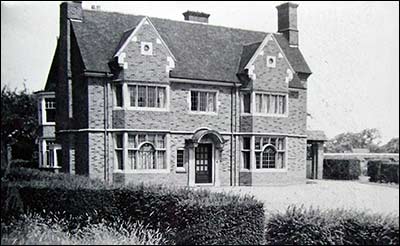 |
This is a photograph of the Castle Hill referred to earlier in this book. The Castle is supposed to have been built of mud bricks and oaken beams, and surrounded by a moat. It appears to have had little historical importance, although Roman coins and pottery have been found in the surrounding earthworks.
Above is a view of the present Manor House which is a modern building set in beautiful gardens of which the lily-pond can be seen on the right, forms a part. As far as can been ascertained from records, the Manor, like the Church, played a prominent part in the religious and social life of the villagers of former days.
|
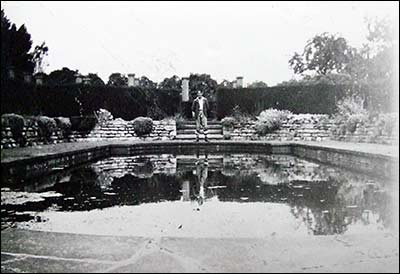 |